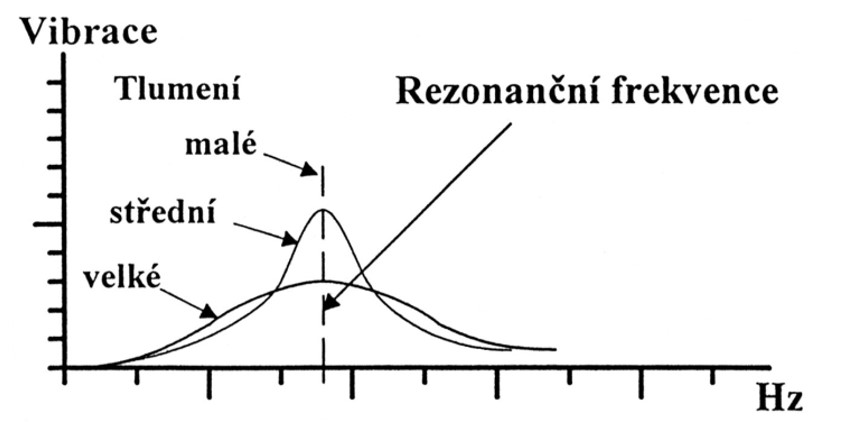Resonance
Resonance as such does not cause vibrations, it only intensifies them, up to high values and causes the high sensitivity of the machine to force action with a resonant frequency. It can be said that resonance is a very common but sometimes unknown cause of large vibrations.
Each part of the machine system (drive unit) has its own stiffness and weight, i.e. when force is applied to these parts, they oscillate, and the oscillation times depend on the already mentioned stiffness and weight, and to which frequency of force action this or that part is particularly sensitive. In practice, that is that when the rotational frequency of the machine (part of the machine) approaches this particularly sensitive frequency (resonant frequency) or the frequency of some alternating excitation force, vibration problems occur – resonance problems. Resonance on the shaft has its name – critical speed, which means that the speed of the shaft approaches its resonance frequency, so a serious problem arises. Then it is clear that friction also plays an important role by reducing vibrations at resonance, i.e. causes muting that has an effect given its size.

If the rotational frequency of the machine is close to the resonance frequency, the vibration behavior will be unpredictable and will change for no apparent reason, which leads to an unequivocal conclusion:
If the operating speed of the machine is equal to or close to the critical speed (resonant frequency), this always indicates problems with large machine vibrations.
Symptoms of these problems may be as follows:
- unstable vibration level
- temperature sensitivity
- significant sensitivity to unbalance
- difficult balancing
- significant seal wear
- occasionally damage to the rotor occurs
The actual procedures for a simple resonance test are as follows:
- We increase the revolutions of the machine and at the same time measure the vibrations in the vertical direction, they initially increase in proportion to the revolutions, then when approaching the resonance frequency, its amplifying effect occurs and after a further increase in revolutions, the vibrations decrease.
- On the bearing housing, we measure the amplitude of the vibrations in the V, H, A direction, and then evaluate it as described below.
- Implementation of the so-called simple resonance test, the essence of which is the measurement of vibration magnitudes as a response to an exciting force (impact). The impact and the sensor must be placed assymmetrically as possible, i.e. e.g. on the bearing housing, a shock from one side and the sensor from the other side, but they must not be close to each other again. Repetition of the impact at an interval of approx. 3 seconds for the duration of the measurement by the measuring device and by performing the frequency spectrum measurement actually achieves, with a certain exaggeration, the performance of an operational modal analysis. The limitation is given by a number of factors, but above all the possibility of exciting the excitation force in the object. Not every blow to large and substantial objects will elicit a measurable response.
From the given procedures, we get certain answers from which the following conclusions can be drawn.
- We can find out the resonant frequency by measuring the rotational frequency at which the vibrations are greatest,
- We will measure the level of vibration in the vertical, horizontal and axial directions. Let’s compare their size. If the vibration in one of these directions is at least three times greater than in the other two directions, it is probably due to resonance.
- By measuring, we get a spectrum where the highest vibration levels correspond to resonant frequencies.
It is certainly logical that if there are two signs of resonance, then our decision certainty increases. After answering this crucial question, we must look for the answer to the second question: “How close can the operating speed be to the resonant frequency?”. But first, let’s summarize the initial facts:
- If the vibration amplification is at least three times, the operating speed can be close to the resonant frequency.
- If the vibration damping is small, the resonance curve is slender and the operating speed can be close to the resonance frequency without the vibration amplification showing any significant effect.
- If vibration damping is significant, the operating speed may be close to the resonant frequency and the vibration amplification may be very small.
Since we essentially never know the damping level, we follow the following convention:Working revolutions should be spaced ± 30% from the resonance frequency. The same applies to other excitation forces that arise from the operation of the machine.
The solution to the whole problem is the so-called dynamic tuning of machines, the clear goal of which is to reduce the size of vibrations. It is certainly obvious that changing the excitation frequency will achieve the desired effect. In operational practice, this is, for example, a change in working speed, a change in the stiffness of the structure, a design solution for damping vibrations, etc.